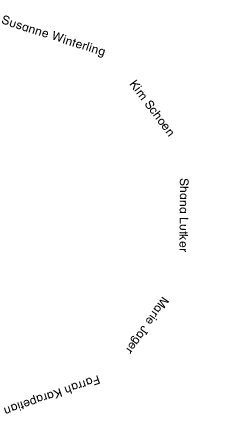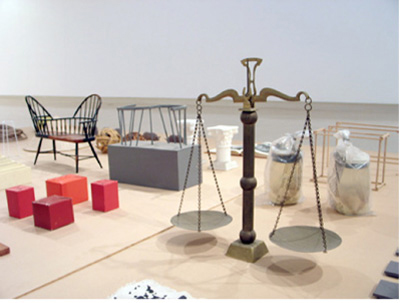
Shana and I met in her studio a couple times, about a year apart, with not much art around, as her work had just been shipped out for a show in both cases. We talked about what she might want to do for this exhibition. And, as the exhibition grew closer, we began to speculate around the idea of transitional objects. She showed me some objects that she had on her shelves in the studio: an old rubber arm pad from a crutch, a lampshade. I wondered how these objects had informed her previous work, or how they would trigger another kind of response for a future work. These fragments seemed to contain something potent and integral to Shana’s practice. I emailed her some questions about the issues she brought up in our conversation, and the text that follows was her response:
October 24, 2010I had a dream this morning, it was late in the morning, and I should have probably already been awake. The dream was set in the present moment. I was lying in bed, and I had just finished reading a new novel by Chris Kraus. The last chapter of the novel was written in symbols, small drawings representing gestures in sign language. The drawings were rendered very graphically; thin, clean line drawings, each symbol for word or letter contained in a small rectangle. I didn’t know enough sign language to understand, so the book just dissolved into these little drawings. In some of the icons, the signing hands were in front of a woman’s face, her expression vacant, but I thought she looked both a little frustrated and very patient. I wondered if the drawing of the woman was supposed to be Kraus, or if it was a generalized “woman,” a symbol of a woman signing the symbols of sign language. And I wondered if Kraus had drawn the icons, if they were her symbols, and if the chapter could be read at all or if it was just supposed to be looked at. The symbols themselves were insufficient representations of sign language, without notation of movement or direction for the hands, some were repeated a bunch of times in a row. The first chapter of the book had been very theoretical, the second rather personal and diaretic, and this, the third chapter, was just a few pages of these hand gestures. I thought maybe the third chapter couldn’t be translated into paragraphs or complete thoughts, impossible to articulate as words, resistant to that kind of logical organization. It was about feelings, Kraus’s feelings. The transition between the three modes of address in the chapters of the book acknowledged the failure of language to represent experience. An ode to the failures of representation, the incomplete-ness of language.
The collected objects presented in the Rose Peebles exhibition, under the title Transitional Objects, are something like the third chapter of this book that doesn’t exist.
They are fragments of ideas, repeated, abstracted, reiterated things and images that gesture towards something without necessarily knowing how to describe what that “something” is yet; premature, underdeveloped. As research objects, some of them have been reprocessed or re-made as finished works of art. Some of the objects are failures, failed ideas that did not yield independent objects, but still feel almost-right or part-right. Some were made to be only props, but appear independent when photographed. Some will be reprocessed or repossessed in future work. The objects are also rather personal. The intimacy comes in part from the incompleteness; they are not ready yet, they are embarrassed to be seen. Here, collected, the fragments also offer a re-staging of the oft-arduous process of arriving at a “finished” thought or object. Transitional objects are missing something, or, they represent the idea that we are missing something. In developmental psychology, transitional objects are the blankets or dolls that children become attached to as they deal with the anxious realization that that are separate from their mothers, independent beings, but they are also completely dependent on their mothers to fulfill their wishes. There is anxiety and fear in the recognition of the gap between knowing what we want and getting what we want. A transitional object is often the first thing that really belongs to the child and that the child understands as her own possession. The “me” has a “not-me.” For psychologist Winnicott, transitional objects and phenomena, later in life, are those things that are neither subject or object, but somewhere in between, a bit of “me” and “not-me.”
Many of the objects in this piece were chosen because they seemed, somehow, to embody a fragment of an idea inside my head, outside of my head. The discoveries of these objects are very strange moments of self-recognition—to see an idea, a part of oneself, reflected in an object; a partial mirror, a resemblance or uncanniness, in a thing. They are subjective objects, subjected objects. And when these fragments of recognition are presented together, they are an archive or seedbed of ideas, of the idea of ideas.
The Transitional Objects might be legible as an attempt to show the process of communicating ideas as objects, it might seem partially familiar to viewers. Or, the piece could read as an aestheticized collection of objects, or, perhaps it will just look like a jumble of junk, some kook’s yard sale.

